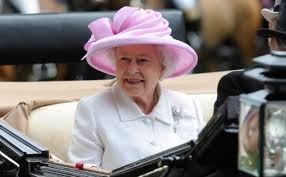In this year celebrating the Diamond Jubilee of Queen Elizabeth II’s reign, we can look back on those majestic beings who top the longevity lists for English monarchs.
Still number one is Her Imperial Majesty Victoria Regina (1819-1901) with sixty-three years, 216 days on the throne, from 1837 to 1901.
Victoria’s Coronation portrait by artist George Hayter, 1837
Perfectly indicative of the incredible changes in the world during her long reign is the fact that she was portrayed at the beginning by an artist in oils and near the end by a photographer.
Queen Victoria’s Diamond Jubilee Portrait, 1897
She celebrated the only Royal Diamond Jubilee until this year. Below is one of the many souvenirs created for the event. Festivities took place all over the empire, as they will throughout the Commonwealth for Elizabeth II’s Diamond Jubilee this year.
Elizabeth II was born in 1926 to the second son of King George V, the future King George VI (1895-1952) and his wife, Elizabeth Bowes-Lyon, later best known as the Queen Mother (1900-2002). The present Queen succeeded her father upon his death in 1952 and was formally crowned in 1953. Now in second place for longevity of reign, Elizabeth II might surpass Victoria’s record in another four year or so.
Elizabeth II in 1953
The official Diamond Jubilee Portrait by John Swannell
I rather prefer her in the pink hat worn at Ascot in 2011!
Number three in longevity is George III who reigned from October 25,1760, when he was merely 22 and succeeded his grandfather George II, to January 29, 1820, though his duties had been taken over in 1811 by his son, George, Prince of Wales, as Regent.
George III, by Allan Ramsay, 1762
George III is perhaps most renowned in the U.S. as the King who “lost the colonies” for his country. It is said that this fact plagued him for many years. But his eventual mental breakdowns were more likely to have been caused by inherited disease, usually attributed to porphyria, from which other members of the Hanoverian family may have suffered.
In fourth place is James I (1566-1625), because his time as James VI of Scotland is included. James I was the son of Mary, Queen of Scots (1542-1587), and was crowned King of Scotland at age 13 months in 1567. Mary was a cousin of Elizabeth I, but the two women were never to overcome the rivalries of their circles and develop a cooperative relationship. Elizabeth I (1533-1603) eventually had Mary put to death.
 |
| Mary, Queen of Scots, by Nicholas Hilliard, c. 1578 |
Ironically, it was Mary’s son James, the Scottish King, who untied Britain and Scotland and became Elizabeth I’s successor, King James I.
James I
Britain under James I continued its Renaissance flowering of literature (Shakespeare, Donne) and the arts in what became known as the Jacobean Age. The bible — King James Version — was translated into English; we celebrated 400 years of this great work in 2011.
The next two monarchs in longevity are Henry III (reigned 1226-1272) and Edward III (reigned 1327-1377), 56 and 50 years respectively. Next is William I of Scotland (1165-1214), followed by Llywelyn of Gwynedd (1195-c.1240).
Taking 9th place in longevity is Elizabeth I (1533-1603), who followed her sister Mary Tudor and brother Edward VI as a successor to Henry VIII. Elizabeth was age 25 when she was crowned and reigned for more than 44 years.
detail of Elizabethan procession, c. 1575
Our own Elizabethan Age began in 1952. Above is the Queen with her consort, Prince Philip, Duke of Edinburgh. The royal couple has celebrated their 64th wedding anniversary.
Elizabeth has been on the throne throughout the terms of office of eleven U. S. presidents, from President Eisenhower to President Obama. Congratulations and best wishes to Elizabeth II and Philip — and all their children, grandchildren, and great grandchildren too.
Elizabeth II and some of her subjects
The official Jubilee website is here.









.jpg)


